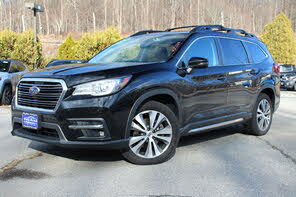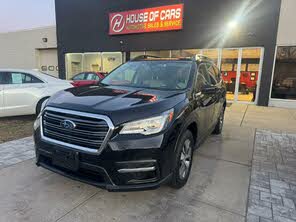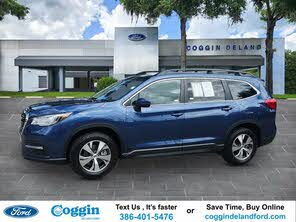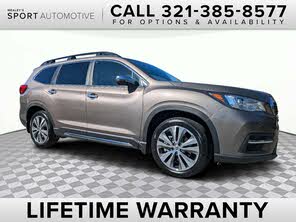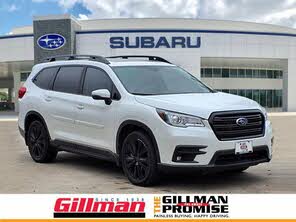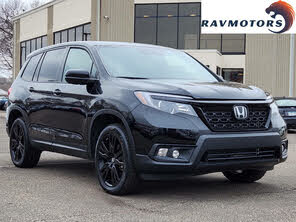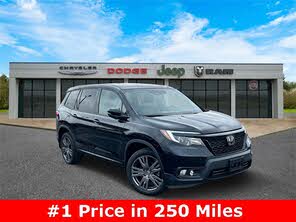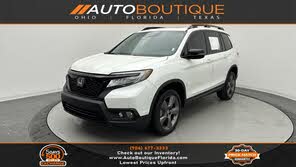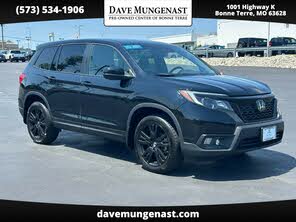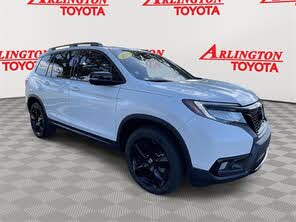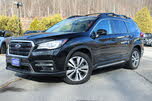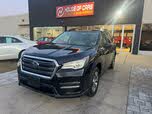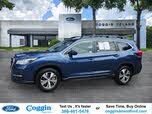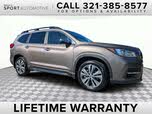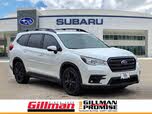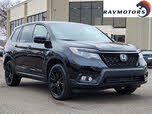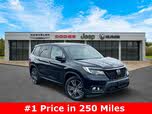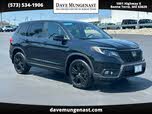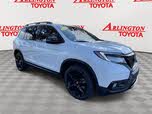2021 Subaru Ascent vs 2021 Honda Passport
Overview | |
MSRP$32,295 | MSRP$32,790 |
Average price$27,587 | Average price$27,876 |
Listings622 | Listings1126 |
Ratings & Reviews | |
User Reviews | User Reviews |
Expert reviews8.5 out of 10 | Expert reviews8.0 out of 10 |
Pros
| Pros
|
2021 Subaru Ascent Reviews SummaryFew automakers have the brand loyalty enjoyed by Subaru—and with good reason. Its cars, wagons, and SUVs are safe, reliable, and provide features like standard all-wheel drive (AWD). A three-row SUV with all of these benefits seems like a no-brainer, and so the 2021 Subaru Ascent is ideally positioned to differentiate itself from the rest of this family-hauling segment. In addition to its spacious cabin and a long list of standard features, the Ascent gains a few key safety features as newly standard equipment. | |
2021 Honda Passport Reviews SummaryThe 2021 Honda Passport was introduced for the 2019 model year. It carries over to 2021 largely unchanged, but with some additional features. First used by Honda in the early 1990s, the Passport name harkens back to a time when SUVs were more about rugged off-road capability. SUVs are very different beasts these days, and the Passport bridges the gap as an adventurous crossover SUV that is designed with daily life in mind. The Passport is closely related to the Honda Pilot. The fact that Honda offers multiple midsize SUVs might seem confusing. Automakers always talk about not wanting one model to cannibalize sales of another. Though the Honda Passport and the Honda Pilot are in the same category, the Passport stands out as a more active alternative. It leverages that older more rugged Honda nameplate and backs it up with some features not found on the family-hauling Pilot. | |
No video found | No video found |
Popular Features & Specs | |
Engine2.4L 260 hp H4 | Engine3.5L 280 hp V6 |
Drive TrainAWD | Drive TrainFWD |
Seating Capacity8 | Seating Capacity5 |
Horsepower260 hp @ 5600 rpm | Horsepower280 hp @ 6000 rpm |
MPG City21 | MPG City20 |
MPG Highway27 | MPG Highway25 |
Engine | |
Engine Name2.4L 260 hp H4 | Engine Name3.5L 280 hp V6 |
Torque277 lb-ft @ 2000 rpm | Torque262 lb-ft @ 4700 rpm |
Horsepower260 hp @ 5600 rpm | Horsepower280 hp @ 6000 rpm |
DrivetrainAWD | DrivetrainFWD |
Fuel Economy | |
MPG City21 | MPG City20 |
MPG Highway27 | MPG Highway25 |
Interior | |
Seating Capacity8 | Seating Capacity5 |
Safety | |
Front Crash Overall5 | Front Crash Overall4 |
Side Crash Overall5 | Side Crash Overall5 |
Dimensions & Capacity | |
Cargo Space17.8 cu ft | Cargo Space41.2 cu ft |
Curb Weight4430 lbs | Curb Weight3959 lbs |
Height71.6 in | Height71.6 in |
Length196.8 in | Length190.5 in |
Width85.7 in | Width78.6 in |
Wheelbase113.8 in | Wheelbase111.0 in |
Maximum Payload1570 lbs | Maximum Payload1332 lbs |
Number of doors4 | Number of doors4 |
Maximum Towing Capacity2000 lbs | Maximum Towing Capacity3500 lbs |
Overview | ||
MSRP | $32,295 | $32,790 |
Average price | $27,587 | $27,876 |
Listings | ||
Ratings & Reviews | ||
User reviews | ||
Expert reviews | 8.5 out of 10Read full review | 8.0 out of 10Read full review |
Pros & cons | Pros
| Pros
|
Summary | Few automakers have the brand loyalty enjoyed by Subaru—and with good reason. Its cars, wagons, and SUVs are safe, reliable, and provide features like standard all-wheel drive (AWD). A three-row SUV with all of these benefits seems like a no-brainer, and so the 2021 Subaru Ascent is ideally positioned to differentiate itself from the rest of this family-hauling segment. In addition to its spacious cabin and a long list of standard features, the Ascent gains a few key safety features as newly standard equipment. | The 2021 Honda Passport was introduced for the 2019 model year. It carries over to 2021 largely unchanged, but with some additional features. First used by Honda in the early 1990s, the Passport name harkens back to a time when SUVs were more about rugged off-road capability. SUVs are very different beasts these days, and the Passport bridges the gap as an adventurous crossover SUV that is designed with daily life in mind. The Passport is closely related to the Honda Pilot. The fact that Honda offers multiple midsize SUVs might seem confusing. Automakers always talk about not wanting one model to cannibalize sales of another. Though the Honda Passport and the Honda Pilot are in the same category, the Passport stands out as a more active alternative. It leverages that older more rugged Honda nameplate and backs it up with some features not found on the family-hauling Pilot. |
Video | No video found | No video found |
Popular Features & Specs | ||
Engine | 2.4L 260 hp H4 | 3.5L 280 hp V6 |
Drive Train | AWD | FWD |
Seating Capacity | 8 | 5 |
Horsepower | 260 hp @ 5600 rpm | 280 hp @ 6000 rpm |
MPG City | 21 | 20 |
MPG Highway | 27 | 25 |
Engine | ||
Engine Name | 2.4L 260 hp H4 | 3.5L 280 hp V6 |
Torque | 277 lb-ft @ 2000 rpm | 262 lb-ft @ 4700 rpm |
Horsepower | 260 hp @ 5600 rpm | 280 hp @ 6000 rpm |
Drivetrain | AWD | FWD |
Fuel Economy | ||
MPG City | 21 | 20 |
MPG Highway | 27 | 25 |
Interior | ||
Seating Capacity | 8 | 5 |
Safety | ||
Front Crash Overall | 5 | 4 |
Side Crash Overall | 5 | 5 |
Dimensions & Capacity | ||
Cargo Space | 17.8 cu ft | 41.2 cu ft |
Curb Weight | 4430 lbs | 3959 lbs |
Height | 71.6 in | 71.6 in |
Length | 196.8 in | 190.5 in |
Width | 85.7 in | 78.6 in |
Wheelbase | 113.8 in | 111.0 in |
Maximum Payload | 1570 lbs | 1332 lbs |
Number of doors | 4 | 4 |
Maximum Towing Capacity | 2000 lbs | 3500 lbs |
When it was introduced for the 2019 model year, the Ascent seemed like a long-overdue addition to the Subaru lineup. Three-row SUVs had dominated for the past decade, so a vehicle like this was a glaring hole in the Subaru lineup. Subaru had attempted a three-row model before, in the form of the Tribeca, but it was a half-measure and was universally panned. A horrendous front-end design did damage that no mid-cycle refresh could repair. Perhaps it was a smart move by Subaru to put a bit of distance from the Tribeca before another foray into the segment.
The Ascent looked exactly like what one might imagine a three-row Subaru SUV would look like before ever seeing it. It had elements of the smaller Forester crossover SUV and the Outback wagon, but scaled up into a three-row midsize SUV. The cabin was the same story, as the dash design could be interchangeable with other Subaru models. That's probably how Subaru wanted it. The automaker likely wanted shoppers to make the connection between the Ascent and its other popular models.
The Passport was essentially a shortened Pilot, with two rows of seats instead of three. It was easy to see just from looking at it. Frankly, the two SUVs were so similar, you could call the Passport a Pilot Sport.
Styling similarities continued inside the cabin. The Passport’s dash layout was visually identical to that of the Pilot. The downside to that was that they both shared Honda’s awkward “button shifter” design, rather than a conventional lever to control the automatic transmission. Corporate design choices aside, the Passport had a spacious interior, and plenty of high-quality materials were used throughout.
No matter which trim you selected, the Ascent was powered by a turbocharged 2.4-liter boxer four-cylinder engine. It made 260 horsepower and 277 pound-feet of torque. Power was routed through a continuously variable transmission (CVT) to Subaru’s Symmetrical All-Wheel Drive system.
Though some shoppers might have preferred the idea of having a premium engine option, this standard engine got the job done in most driving scenarios. It was most effective getting around town, but held its own when getting up to highway speeds or making a passing maneuver.
The Ascent’s ride was focused on refined comfort. It was no sports car, but it was responsive through corners and soaked up bumps in the road. This was key in the inclement regions where Subarus were often popular choices. The Ascent featured 8.7 inches of ground clearance, which was more than some conventional SUVs. Along with the standard all-wheel drive and Subaru’s X-Mode system, the Ascent was a brute in the snow and could handle some light off-roading. Think, “getting to the ski mountain or remote campsite" not "tackling the Rubicon Trail."
The Ascent was rated to tow up to 5,000 pounds and included a standard Trailer Stability Assist.
No matter which trim you selected, the Passport came standard with a 3.5-liter V6 engine that made 280 horsepower and 262 pound-feet of torque routed through a nine-speed automatic transmission. The Passport got standard front-wheel drive (FWD) or optional all-wheel drive (AWD). The V6 provided strong acceleration and the automatic managed power well. The engine's stop-start system could be abrupt at times, but luckily, there was a switch to cancel out this system.
The Passport’s ride offered an ideal blend of comfort and refined handling abilities. No one should have been taking this car on the Rubicon Trail, so the ride was optimized for the commuter and the weekend warrior. That said, it did offer 8.1 inches of ground clearance and the AWD model’s Intelligent Traction Management included Snow, Sand, and Mud drive modes. If you planned on taking the Passport off the beaten path, the TrailSport trim, which arrived for the 2022 model year, was worth considering. If you planned on towing, FWD Passports could tow up to 3,500 pounds, according to Honda. When properly equipped, the AWD Passport could tow up to 5,000 pounds.
The Ascent provided 17.8 cubic feet of cargo space behind the third-row seats. Dropping the third row brought cargo capacity to 47.5 cubic feet. With all rear seats folded down, the Ascent provided up to 86.5 cubic feet of cargo space. That figure was on the higher end of the midsize three-row SUV class, but some rivals offered more. The Volkswagen Atlas delivered up to 96.8 cubic feet, for example, and the Chevrolet Traverse offered up to 98.2 cubic feet.
The Ascent came standard with a power liftgate, but there was no option for a hands-free power liftgate. That wasn’t a dealbreaker, but it was becoming an increasingly popular option in the segment.
In base configuration, the Ascent provided seating for up to eight passengers. Opting for the second-row captain's chairs brought seating capacity to seven. The first two rows were incredibly spacious, providing plenty of headroom and legroom. The third row could accommodate adults for shorter trips, but was better suited for kids on longer hauls. The Ascent provided an impressive 19 cupholders spread across all three rows. There were plenty of trays and cubbies for gear everywhere as well.
With the rear seats folded, the Passport provided a generous 100.8 cubic feet of cargo space. With the second row in use, the Passport provided up to 50.5 cubic feet of cargo space. There was even an additional 2.5 cubic feet in an under-floor storage tray. The EX-L trim came with a power liftgate, while the Touring and Elite trims included a hands-free power liftgate.
The upright seating position made for terrific visibility as well as a commanding view of the road. The center console featured a deep center bin as well as an open cargo tray below the shifter and cupholders. Both front and rear seats featured deep in-door pockets for water bottles and other items.
The rear seats offered plenty of headroom and legroom. They also both reclined and slid, making them very accommodating.
Subaru's StarLink infotainment system boasted logical menu layouts and large, easy-to-read icons for both of the Ascent's available touchscreens. Both screens were also backed by hard buttons and dials, as well as a home button to get you out of any menu. Apple CarPlay and Android Auto were standard as well.
The Ascent came standard with two front USB ports, two second-row USB ports, satellite radio, and Bluetooth connectivity. Available tech features included third-row USB ports, a WiFi hotspot, and a 14-speaker Harman Kardon premium stereo.
For 2021, Honda made Android Auto and Apple CarPlay standard on the Passport. The smartphone connectivity features were included with the newly-standard 8-inch touchscreen infotainment system. This was a distinct advantage over the three-row Pilot, which required moving up to at least the EX trim to get CarPlay and Android Auto.
Making these features standard was a great move, but Honda still had a long way to go when it came to infotainment controls. The Passport's infotainment system had dated graphics, a confusing menu layout, and a volume dial that felt like an afterthought. Perhaps we should be grateful that Honda even included a volume dial, as the audio interface lacked a tuning dial.
The Ascent was an Insurance Institute for Highway Safety (IIHS) 2021 Top Safety Pick+. This was due to its crash test results, as well as Subaru’s comprehensive suite of driver-assistance features, called EyeSight. This included automatic emergency braking, adaptive cruise control, and lane departure warning. EyeSight also had a helpful feature that let you know if the vehicle in front of you had pulled away when stopped in traffic or at a stoplight. For the 2021 model year, the Ascent gained standard automatic high beams, as well as headlights that bent with the steering angle.
The Ascent was also available with a number of optional safety features, such as reverse automatic emergency braking, rain-sensing windshield wipers, blind-spot monitoring, and rear cross-traffic alert.
The Passport came well equipped with advanced safety features such as automatic emergency braking, forward collision warning, lane departure warning, and adaptive cruise control that could stop and go with the flow of traffic. Buyers could opt for available driver assistance features such as blind-spot monitoring, rear cross-traffic alert, and front-and-rear parking sensors.
In evaluation by the National Highway Traffic Safety Administration (NHTSA), the Passport scored an overall rating of five out of five stars. The Insurance Institute for Highway Safety (IIHS) gave the Passport top "Good" scores in most crash tests, and an "Acceptable" rating in the passenger-side small overlap front crash test. The Passport only managed "Acceptable" ratings for headlights and child-seat anchor ease of use, and a second-tier "Advanced" rating for front crash prevention tech.
CarGurus highlights

According to CarGurus experts, the overall rating for 2021 Subaru Ascent is 8.5 out of 10, while the 2021 Honda Passport scores 8.0 out of 10. Based on these ratings, the Subaru Ascent is the recommended choice for its higher overall rating, advanced safety features, and versatile three-row seating.
Choose the 2021 Subaru Ascent if:
- You need a three-row SUV with ample cargo space and seating for up to eight passengers.
- You prioritize advanced safety features and top safety ratings.
- You want a vehicle with excellent all-weather capability and light off-road prowess.
Choose the 2021 Honda Passport if:
- You prefer a two-row SUV with a spacious interior and generous cargo capacity.
- You value strong V6 performance and refined handling.
- You want standard smartphone connectivity features and a hands-free power liftgate in higher trims.
CarGurus highlights

According to CarGurus experts, the overall rating for 2021 Subaru Ascent is 8.5 out of 10, while the 2021 Honda Passport scores 8.0 out of 10. Based on these ratings, the Subaru Ascent is the recommended choice for its higher overall rating, advanced safety features, and versatile three-row seating.
Choose the 2021 Subaru Ascent if:
Shop Now- You need a three-row SUV with ample cargo space and seating for up to eight passengers.
- You prioritize advanced safety features and top safety ratings.
- You want a vehicle with excellent all-weather capability and light off-road prowess.
Choose the 2021 Honda Passport if:
Shop Now- You prefer a two-row SUV with a spacious interior and generous cargo capacity.
- You value strong V6 performance and refined handling.
- You want standard smartphone connectivity features and a hands-free power liftgate in higher trims.

By: CarGurus + AI
At CarGurus, our team of experienced automotive writers remain at the heart of our content operation, conducting hands-on car tests and writing insightful guides that are backed by years of industry experience. To complement this, we are harnessing AI to make our content offering more diverse and more helpful to shoppers than ever. To achieve this, our AI systems are based exclusively on CarGurus content, ratings and data, so that what we produce is both unique to CarGurus, and uniquely helpful to car shoppers.

















